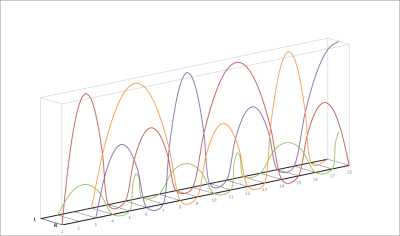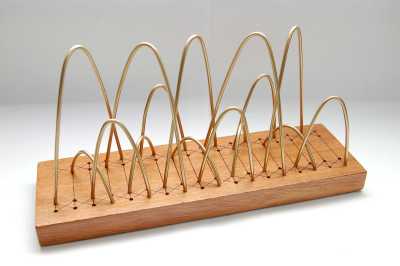|
|
Siteswap Pattern ToolsWhile researching the mechanics of juggling for the Juggler's Slide Rule, I became more familiar with siteswap and other notations, but usually found it hard to visualise what the more complicated patterns would look like juggled. Juggling simulators are good but I wanted something three-dimensional that would also track the pattern in time.
Siteswap Pattern Plot
My first solution was an Excel spreadsheet that would track a pattern on a 3d chart from a siteswap. As most patterns are actually a two dimensional plane in front of the juggler, I could use the 3rd axis for time.
(2012)
 The macro-free spreadsheet can be accessed from these links: Excel 2007/10 xlsx or Excel 2003 xls.
The macro-free spreadsheet can be accessed from these links: Excel 2007/10 xlsx or Excel 2003 xls.
The siteswap is typed into the cells in column A as single numbers, which will highlight red if the siteswap is not a whole number of balls, using weights from 0 (gap) to 20. The chart will update showing the paths of the balls over a number of beats when the workbook calculates. The throw and catch sites (hands, labelled L and R) are fixed for 'normal' juggling, and the beats on the long time axis are labelled. A few parameters can be set, such as the number of beats shown (up to 50), it will display patterns up to and including seven balls, and the chart can be rotated on all three axes. It will plot impossible patterns as long as the number of balls is valid, though this and allowing more and moveable sites could be implemented.
Siteswap Pattern Model
I'm not entirely sure that the Excel plot is that clear, but the next step was to make a physical 'toolkit' version.
(2012)
 The model, which uses the same principle as the graphic plot, is made from a hardwood base with holes drilled, into which correctly sized and shaped brass wires can be inserted to represent the flight paths of balls.
The model, which uses the same principle as the graphic plot, is made from a hardwood base with holes drilled, into which correctly sized and shaped brass wires can be inserted to represent the flight paths of balls.
The main difference to the plot is that the left and right hand sites have two rows of holes each which act as the throw and catch positions. This means that it is slightly more accurate to actual juggling, and rolling in or rolling out can be simulated. The potential problem of two bits of wire occupying the same space when they cross is also alleviated by having distinct throw and catch positions. The base is 28.5cm long by 9cm wide by 2cm high with a rubber pad underneath. The brass bar is 3mm thick. The beats are 1.5cm apart, the throw and catch positions are 1cm apart, and the left to right throw width is 5cm. The height ofa weight 3 throw is 3cm, 4, 5, 6 and 7 are 6.75cm, 12cm, 18.75cm and 27cm respectively, which correspond to a hold time of 1 beat.Scaling up by 8, for a hand width of 0.4m, a 3 is 24cm and a 5 is about a meter, which is a throw rate of about 1.4 balls per second. |
||||